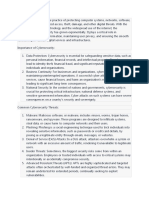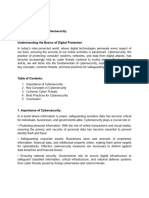0% found this document useful (0 votes)
23 views4 pagesCYBERSECURITY
Cybersecurity involves protecting computer systems, networks, and data from unauthorized access and threats such as data breaches and ransomware. It is essential for safeguarding personal information, securing devices, and ensuring business continuity. Implementing effective cybersecurity requires risk assessment, strategic planning, and ongoing employee training.
Uploaded by
Junfik MatugasCopyright
© © All Rights Reserved
We take content rights seriously. If you suspect this is your content, claim it here.
Available Formats
Download as DOCX, PDF, TXT or read online on Scribd
0% found this document useful (0 votes)
23 views4 pagesCYBERSECURITY
Cybersecurity involves protecting computer systems, networks, and data from unauthorized access and threats such as data breaches and ransomware. It is essential for safeguarding personal information, securing devices, and ensuring business continuity. Implementing effective cybersecurity requires risk assessment, strategic planning, and ongoing employee training.
Uploaded by
Junfik MatugasCopyright
© © All Rights Reserved
We take content rights seriously. If you suspect this is your content, claim it here.
Available Formats
Download as DOCX, PDF, TXT or read online on Scribd
/ 4

























































































